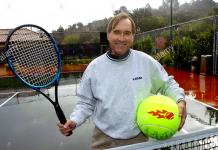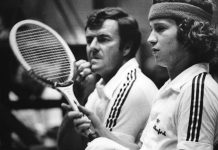Todd Dissly has been fielding the same question over and over since he began teaching a scaled-down brand of tennis more than a than a decade ago.
“The one we always get is, ‘When is my kid going to play REAL tennis?’ What people need to understand is that this IS real tennis,” said Dissly, who runs the Los Gatos Tennis Academy and South Bay Tennis Academy in Northern California. “Look at other sports. When you start playing baseball, do you start at Wrigley Field? When you start soccer, do you play on an Olympic-size field? It’s ridiculous. Tennis is way behind in that respect.”
Dissly is a pioneer when it comes to making tennis more user friendly. At multiple sites across Las Gatos, Saratoga and San Jose, he has adopted a smaller-is-better approach for introducing players to the sport. Recognizing his efforts, the USTA awarded the LGTA an Early Development Center designation, one of only four in the country. (Three are in NorCal, including the San Francisco TC and the Spare Time Inc.)
“We’re really leading the charge as a section on this initiative,” Dissly told Inside Tennis.
He’s now a National QuickStart Trainer, teaching a format in which 10-and-under players compete on smaller courts, using smaller nets and modified balls. There are 36-foot courts with mini nets and red balls that travel at 25 percent the speed of a regular tennis ball; 60-foot courts with a regular net and orange balls that travel at 50 percent speed; and traditional courts with green-dotted balls that travel at 75 percent speed and produce longer rallies.
“It’s revolutionized the game,” said Dissly. “It’s so important, not only in the growth of the game but the quality of play. By scaling the game down, at a young age, players are now learning how to approach and volley, how to find open space on the court. It just doesn’t make sense for a nine-year-old kid to approach the net on a full-size court.”
“It used to take hundreds of lessons before you could rally with the ball. Now we’re getting rallies in the first three or four minutes of a class,” he added. “And it’s not just juniors; it’s adults. We do the same thing for our Adult Recreation Program. We apply the same principles. I can take anyone off the street, with no experience in ANY sport, and have them rallying in three minutes.”
The QuickStart/10-and-Under format has all but done away with the traditional tennis lesson. You know the one; you stand in line seemingly for eternity, and when you finally get to the front, the teaching pro drops a ball right in front of you, right in your strike zone. Then it’s back to the end of the line and more waiting
“That’s become problematic in a number of ways,” said Dissly. “For years, we’ve been teaching the sport as a ‘sending’ sport. We’ve turned that on its head. Now we’re teaching it as a ‘receiving’ sport. Instead of seeing lines of kids and a coach with a basket, we see partner-to-partner activity, where kids are hitting the ball back and forth. They’re getting those reception skills, learning how to move to the right spot.”
Instead of being limited to six players on one court, coaches can now accommodate 20 in the same amount of space. Instead of hitting the ball 100 times, kids are now hitting it 1,200 times.
“Now that it’s become part of the rule change, everyone’s got to take notice. Before, people said, ‘Oh yeah, that’s the program that uses the funny balls.’ Now it’s like, ‘Those guys were actually forward thinking, and we better get on board.'”
Beginning in 2012, LGTA will begin hosting four orange-ball tournaments a year. Dissly hopes it will become a model for other programs.
“We want to become a pilot program where other coaches come in to see how we run the event and take it back to their facilities and grow these 10-and-Under tournaments,” he said.
For info on Dissly’s programs, visit www.lgta.net or call (408) 746-3685



















